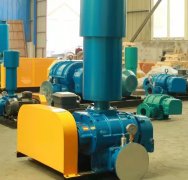The working principle of the composting aeration Roots blower is mainly based on its volumetric gas compression and conveying mechanism. The following is a detailed introduction to its working principle and application:
1、 Working principle
1. Impeller rotation: Roots blowers typically consist of two three bladed impellers. When the motor drives one of the impellers to rotate, the other impeller rotates synchronously at the same speed and in the opposite direction through the action of a synchronous gear.
2. Gas suction and compression: Due to the gaps between impellers, impellers and casings, and impellers and wall panels, a vacuum state is formed at the inlet during the rotation of the impeller, and air is sucked into the inlet chamber under atmospheric pressure. As the impeller continues to rotate, two of the blades of each impeller form a sealed chamber with the wall panel and casing, and the air in the intake chamber is continuously carried to the exhaust chamber by the sealed chamber formed by these two blades. Also, because the impellers in the exhaust chamber are interlocked, the air between the two blades is squeezed out.
3. Gas exhaust: Through continuous inhalation and compression, air is transported from the inlet to the outlet on site, completing the entire gas transportation process. Roots blower has the characteristic of forced gas transmission, which can generate stable and continuous airflow at lower speeds.
2、 Application
1. Composting fermentation: During the composting process of livestock and poultry manure, a Roots blower is connected to an aeration device (such as an aeration disc, aeration head, etc.) to evenly disperse compressed air into the compost. These air bubbles form tiny bubbles that come into full contact with compost during their ascent, increasing the gas-liquid contact area and improving the mass transfer efficiency of oxygen, thereby accelerating the fermentation process of compost.
2. Wastewater treatment: Roots blowers are also widely used in the field of wastewater treatment, mainly for oxygen supply in aeration tanks. Its stable and continuous airflow characteristics can ensure the continuity and stability of oxygen supply in the aeration tank, improving the effectiveness of sewage treatment.
3. Other fields: In addition to composting fermentation and sewage treatment, Roots blower is also widely used in many fields, such as electroplating tank gas transmission, gas burner combustion support, sandblasting device jet gas source, ozone generator gas source, production line drying, air lift pump pumping, grain transportation, pipeline cleaning, humidification device, backwashing, printing machine paper feeding and exhaust, pressure mechanical workpiece molding and demoulding, spray coating spraying, powder particle transportation and special gas transportation.
In summary, the composting aeration Roots blower plays an important role in various fields such as agriculture, industry, etc. due to its working principle and wide application areas.



